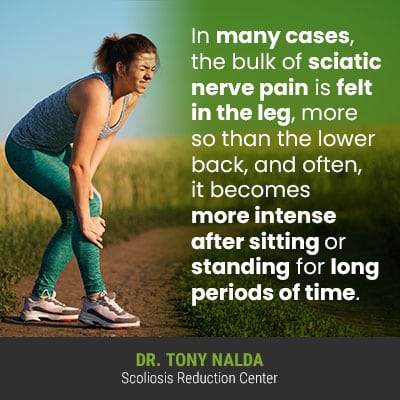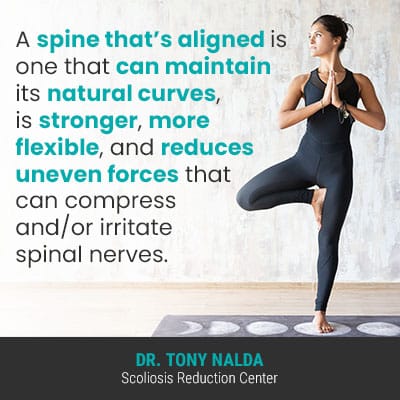If the sciatic nerve is exposed to uneven forces, it can become pinched, inflamed, irritated, or damaged. But if the underlying cause of the sciatic nerve pain is diagnosed and addressed with proactive treatment, the condition is highly treatable.
Sciatica involves pain and discomfort felt at the sciatic nerve’s root or anywhere along its pathway; this is due to the sciatic nerve being pinched. Sciatica pain and symptoms will be dictated by its underlying cause, but in many cases, is highly treatable with conservative treatment.
Many cases of sciatica will resolve on their own in a matter of weeks without treatment, but those with a deeper underlying cause will require proactive treatment to cure sciatica permanently.
What is Sciatica?
The sciatic nerve is the largest and longest in the human body; it’s a mixed nerve consisting of both sensory and motor fibers and starts in the lumbar spine (lower back), extending down the buttock, back of the leg, and into the foot.
In most cases, sciatica only affects one side of the body, most commonly the left, and in rare cases, it can affect both.
When the sciatic nerve is exposed to uneven forces, it can become compressed either at its root, where the nerve originates, or anywhere along its extensive pathway.
If a nerve is compressed, the pressure can pinch it, irritating it, and causing inflammation and/or damage.
Fortunately, if the underlying cause of the sciatica is determined, proactive treatment can be applied early on, prior to any type of permanent sciatic nerve damage.
So for people with sciatica, what types of pain and related symptoms are they likely to experience?
Common Sciatica Symptoms
Sciatic nerve pain can range from mild and intermittent, with periodic flare-ups, to chronic and debilitating, and treatment needs are largely driven by condition/symptom severity and underlying cause.
People with sciatica describe sciatic nerve pain in different ways: sharp jolting pain, shooting pain, electric shock-like pain, burning, stabbing sensations, and feelings of numbness and/or tingling.

In many cases, the bulk of sciatic nerve pain is felt in the leg, more so than in the lower back, and often, it becomes more intense after sitting or standing for long periods of time.
Certain twisting motions can also exacerbate symptoms, as can an unexpected body movement such as a loud sneeze or cough.
When it comes to understanding nerve-related sciatica pain, it’s important to remember that nerves are like limbs of a tree, branching off in multiple directions, which is why nerve pain can be felt far from its site of origin.
As the sciatic nerve is a mixed nerve, sciatica can produce a wide variety of symptoms, including:
- Localized lower back pain
- Radicular pain in the buttock, hip, and leg
- Burning/tingling sensations down the affected leg
- Pain that worsens when sitting
- Weakness/numbness
- Tingling sensations
- Shooting sciatic pain that makes it difficult to stand up from a seated position
The last stages of sciatica can be marked by persistent discomfort and limited mobility, requiring comprehensive treatment to alleviate the symptoms and promote healing.
So when it comes to how to cure these symptoms, we’re talking about applying a customized treatment plan that’s driven by a condition’s underlying cause; this is an important distinction, the difference between solely addressing a symptom, or its underlying cause, the condition itself.
Common Sciatica Causes
The most important aspect of sciatica treatment is that a condition’s underlying cause guides it, so while sciatica has a number of different causes, let’s talk about three of its most common: disc degeneration, lumbar spinal stenosis, and spondylolisthesis.
Disc Degeneration
Disc degeneration is the most common cause of sciatica, and this involves the spine’s intervertebral discs.
The spine is made up of vertebrae (bones) that are rectangular in shape and stacked on top of one another in a straight and neutral alignment.
Adjacent vertebrae are separated by intervertebral discs, which consist of two main parts: a soft gel-like interior known as the nucleus and a tough and durable outer layer known as the annulus.
The discs perform many essential tasks such as providing cushioning between adjacent vertebrae, combining forces to enable flexible movement, and acting as the spine’s shock absorbers.
The discs are the largest structures in the body without their own vascular supply, meaning there is no direct path into and out of the discs for absorbing important nutrients needed for cellular repair, which is why it can be a difficult and lengthy process to reverse disc damage.
If a person’s sciatica is caused by an intervertebral disc issue such as disc desiccation, a bulging disc, or a herniated disc, to cure sciatica, the affected disc has to be treated, and while improvements can be made to restore disc function and prevent further damage, it’s difficult to reverse disc degeneration fully.
The spine deteriorates alongside the rest of the body as we age, and while certain lifestyle factors such as healthy weight and activity levels play a role, in general, the discs are the first spinal structures to show the effects of degeneration.
Discs are made up of 80 percent fluid when we’re born, but as we age, that level drops, and if it drops excessively, this is known as disc desiccation, which commonly presents with degenerative disc disease.
When a disc becomes desiccated, it loses height, and this change in shape can affect adjacent vertebrae attached to it, making it difficult for the spine to maintain its natural curves and alignment.
Once the spine loses one or more of its healthy curves, or one or more of the vertebrae fall out of alignment with the rest of the spine, this introduces uneven forces to the spine: the kind that can irritate nerves.
If a disc is bulging in the lower back, this means it’s pushing out at its edges, intruding on space within the spinal canal, which can cause the sciatic nerve to become pinched.
When a disc herniates, this means the disc’s inner nucleus actually pushes through a tear in its outer annulus, further encroaching on the space within the spine, and if a herniated disc in the lumbar spine is pushing against the sciatic nerve, sciatica can develop.
Lumbar Spinal Stenosis
Lumbar spinal stenosis involves a narrowing of the spinal canal in the lower back, through which spinal nerves pass and branch out to different areas of the body.
With less space for the sciatic nerve to function within, it is vulnerable to impingement and can cause sciatica.
Spinal stenosis can happen anywhere in the back, but is most common in the lumbar spine as the vertebrae and discs of the lower back not only have to support the weight of the spinal sections above but also the weight of the entire trunk.
In addition, it’s the lumbar spine that feels the effects of twisting, bending, and lifting motions, so it’s the most vulnerable to wear and tear and the effects of spinal degeneration.
The most common cause of spinal stenosis is osteoarthritis: the gradual degeneration of the spine’s joints over time.
Spondylolisthesis
Spondylolisthesis is a condition of spinal instability. When it develops in the lumbar spine, this involves a vertebra falling out alignment with the rest of the spine, and slipping down and forward onto the vertebra below.
While some cases of spondylolisthesis don’t produce noticeable symptoms, others can lead to compression of the sciatic nerve and related pain in the lower body as a result.
So now that we’ve explored some of the most common underlying causes of sciatica, what are its treatment options?
How to Cure Sciatica Without Surgery
Fortunately, many cases of sciatica resolve on their own in a matter of weeks, particularly those that are more related to an overuse injury or a temporary strain, and most cases of sciatica can be successfully treated without surgery.
However, when the underlying cause of the sciatic nerve pain is another condition such as degenerative disc disease, lumbar spinal stenosis, or spondylolisthesis, those conditions have to be proactively addressed and treated to achieve long-term and sustainable sciatica relief.
Here at the Scoliosis Reduction Center®, I’ve treated a number of spinal conditions, sciatica included, and once I’ve determined its underlying cause, that factor shapes the crafting of customized scoliosis treatment plans.
I believe in the merits of proactive treatment applied as close to the time of diagnosis as possible; this helps increase the chances of treatment success and in the context of sciatica, helps prevent permanent nerve damage from occurring over time.
Under a conservative chiropractic-centered treatment approach, I integrate different treatment modalities for the most specific and customized results.
Here’s how to get rid of sciatica.
Chiropractic Care
Through condition-specific chiropractic care, I can identify any areas of vertebral subluxation, and through gentle and precise adjustments, I can work towards repositioning affected vertebrae back into alignment with the rest of the spine.

A spine that’s aligned is one that can maintain its natural curves, is stronger, more flexible, and reduces uneven forces that can compress and/or irritate spinal nerves.
When a disc issue is the cause, I focus treatment on the affected disc, its adjacent vertebrae and making improvements to the disc’s surroundings by increasing circulation so it can absorb important nutrients needed for repair and restoration.
By realigning adjacent vertebrae, I’m also helping the related disc reclaim its central position between the two vertebral bodies, which takes the pressure off the disc, and its surrounding nerves.
Identifying and addressing areas of vertebral subluxation in the lumbar spine through chiropractic care can also help with creating space within the spinal canal, relieving pressure on the sciatic nerve.
Physical Therapy
When combined with chiropractic care, condition-specific physical therapy exercises and stretches can be highly effective for treating sciatica by increasing core strength so the spine is optimally supported and stabilized by its surrounding muscles: taking pressure off the discs to maintain the spine’s natural curves and alignment which will help reduce pain and relieve pain.
Custom-prescribed home exercises can help sustain treatment results, and also working towards increasing pelvic/hip flexibility through a variety of exercises and stretches can help strengthen the lower back, so it’s less vulnerable to wear and tear.
Physical therapy is known to treat, and help prevent sciatica by strengthening and mobilizing the soft tissues in the lower back, abdomen, pelvis, buttocks, and legs, and also provide sciatica pain relief.
Physical therapy can also work towards restoring function in the lumbar spine and its joints for better mobility and range of motion.
Using physical therapy as a facet of sciatic treatment is designed around the following goals:
- Restoring functional movement patterns
- Relieving sciatic nerve pain felt in the lower back, buttock, thigh, and leg
- Restoring the function of the lumbar spine and its joints
- Reducing muscle spasms
- Improving lower-body mobility
- Reduce inflammation
Managing dextroscoliosis is an essential aspect of addressing and potentially finding relief for sciatica, offering a holistic approach towards a more permanent cure.
As you can see, when combined with chiropractic care that has the potential to impact the spine on a structural level, physical therapy exercises and stretches can help cure/decrease sciatic nerve pain in a number of ways.
Conclusion
For those suffering from sciatic nerve pain, it can be debilitating, particularly if left untreated, or when treatment is shaped around addressing pain solely as a symptom, rather than addressing its underlying cause.
When it comes to how to cure sciatica permanently, we are talking about the comprehensive crafting of a customized treatment plan driven by severity and causation.
Sciatica involves the sciatic nerve becoming pinched, compressed, irritated, inflamed, and/or impinged, causing pain felt either at its root, or anywhere along its extensive pathway through the lower body.
Here at the Scoliosis Reduction Center®, I treat my sciatica patients by integrating different nonsurgical treatment disciplines such as condition-specific chiropractic care and physical therapy.
Through chiropractic care, I can impact the condition on a structural level by identifying and treating areas of vertebral subluxation by creating more space within the spinal canal so the spinal nerves can function optimally.
When combined with chiropractic techniques, physical therapy can be an invaluable treatment tool for sciatica treatment by increasing core muscle and spinal strength and flexibility; by doing so, there is less pressure on the spine and its individual structures and joints, to maintain its natural and healthy curves.
By using condition-specific exercises and stretches, I can also help patients make improvements to hip and pelvic flexibility, restore healthy movement patterns, and reduce the risk of strain or injury.





